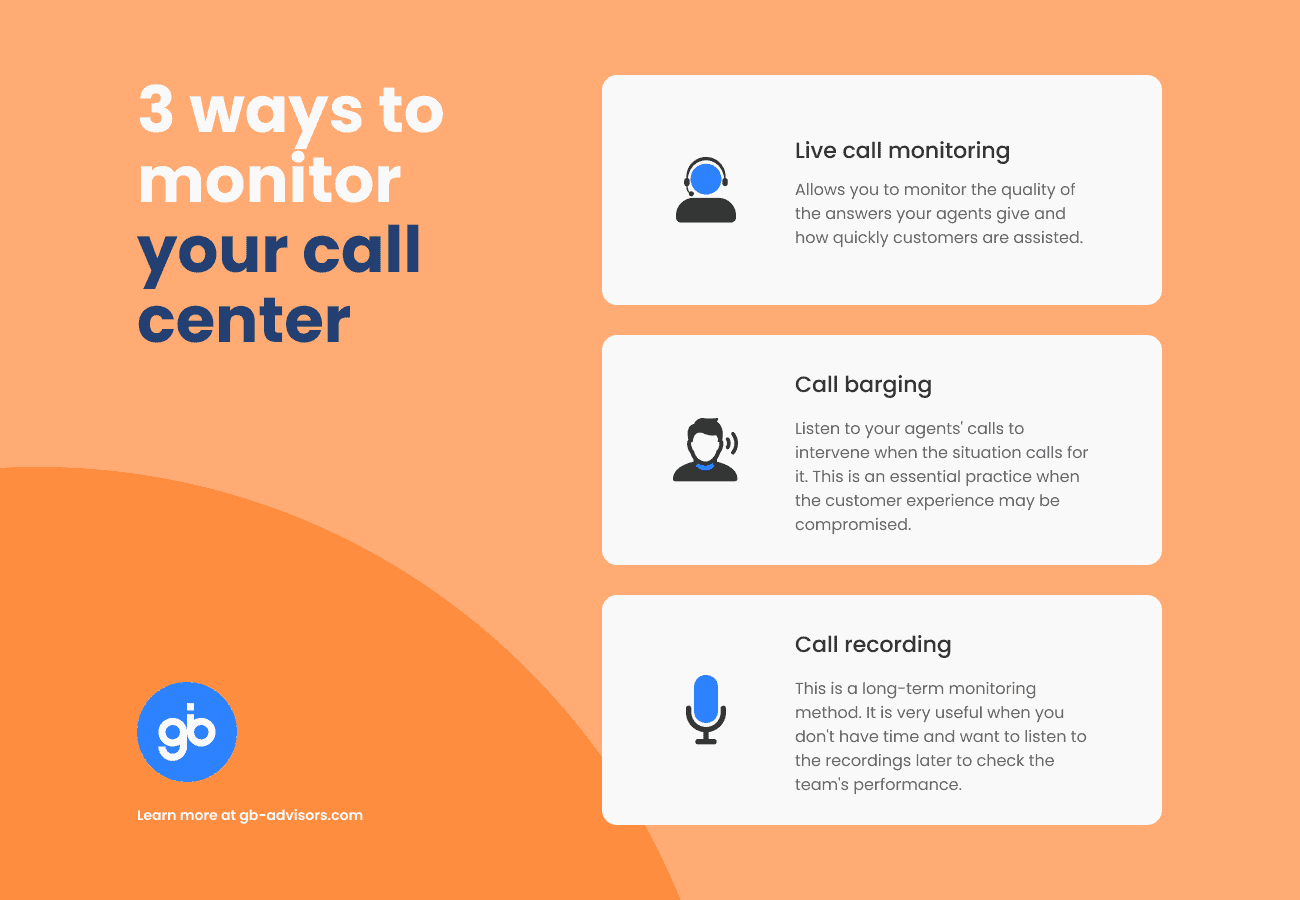Call monitoring is the main function of Call Center supervisors. It is performed with the purpose of listening to the conversation between agents and customers to evaluate the performance of the team, the quality of their interactions, and communication strategies.
However, quality monitoring in the call center is not limited to listening to calls. On the contrary, it includes all agent-related information such as:
- Availability
- Number of agents in conversation
- Number of agents on the line
- Service level compliance
To monitor call quality effectively, we share with you 3 key ways to monitor your Call Center. Let’s see!
How can you monitor the quality of your call center?
There are three fundamental ways to monitor calls. Each of them can be done separately or together, depending on what you want to achieve.
These are:
1— Real-time call monitoring
Ongoing call monitoring allows you to monitor the quality of the answers your agents are giving and how quickly customers are being assisted. You can log in to listen discreetly in real-time, or you can simply monitor the time of calls that are running and detect if agents are exceeding the stipulated handling time.
Logging in on calls is a good practice when you have new employees and need to make sure they do a good job. This way, you can give them feedback to accelerate their improvement and growth within the organization.
However, it is a way to evaluate your entire call center to make sure you maintain good service. It detects weaknesses that need to be improved and skills that can be rewarded to keep your team motivated.
2— Call barging
Call barging is the practice of listening in on your agents’ conversations and intervening when the situation calls for it.
Like real-time call monitoring, this method is very useful when new agents come in. However, there may also be times when more experienced agents require backup in the event of:
- Attending a particularly complicated case.
- A call with a difficult-to-handle customer.
In general, intervening on calls is essential when the customer experience may be compromised.
And, in either case, always remember the importance of giving feedback to your employees. The purpose of these practices is to drive the growth of your agents to optimize the quality of your service.
3— Call Recording
Call recording is a method of long-term monitoring. It is very useful in times when you do not have time on a daily basis to listen to calls in real-time.
Thus, you can listen to the recordings later to monitor your team’s performance.
In addition to evaluative practice, the advantage of recording calls is that they can remain as a reference for future talent. Record the conversations of your best agents and have them in your knowledge base to train others.
You can even record those calls where you are going to intervene, as it is also useful to teach employees how to handle or deal with certain difficult or tense situations.

Benefits of implementing call monitoring
As you can see, monitoring calls is vital to improving the performance of our agents. But more than that, it also allows you to:
Get to know your customers better
By monitoring calls in real-time, you can hear directly from the customer their main concerns, the problems they face, and what they expect from you.
This information is essential to develop a more accurate profile of your buyer persona. This way, you can customize your interactions and provide a more satisfying customer experience.
Detect strengths and weaknesses
You can also listen to or record calls to learn what your agents are doing well and what they need to improve.
And don’t just focus on the negative. Rewarding human talent is key to increasing employee retention. Be sure to congratulate them on their performance. Besides, good performance can lead to improvements as well.
For example, identify which of your agents perform best and make their customer service a guideline for others.
Increase conversion rate and loyalty
Knowing your customers better and, at the same time, helping your employees optimize their performance, allows you to provide a better customer experience. This not only ensures that those at the beginning of the sales funnel move faster to conversion, but also that the customers who bought from you become loyal to your brand.
Calculate essential indicators in a Call Center

The data obtained from monitoring will help you to accurately calculate essential business metrics such as:
- First Call Resolution Rate (FCR): percentage of calls resolved on the first contact. It is important to keep this rate low to reduce the volume of callbacks and service costs.
- Average Operational Time: the average assistance time. The duration time is inversely proportional to the efficiency of the service. In other words, the longer the call duration, the less effective the service, and vice versa.
- Call availability: determines the frequency with which an agent is available to attend to users.
- Abandonment rate: this is the percentage of calls abandoned by customers who did not complete the purchase process or dropped out because they did not obtain a resolution to their problem.
These benefits can be obtained through call monitoring in any of its forms. Of course, you can only do this with the support of the right tools, such as contact center software. These allow you to track calls, as well as centralize all the data so that you can easily visualize it.
Do you currently have this technology or the one you have is outdated? Let us know your challenges or achievements in this regard. And if you need help with this topic, contact us for free advice 😊



